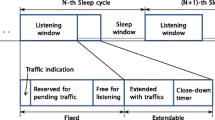Abstract
We investigate how much power saving can be achieved for a Push-To-Talk (PTT) service by employing sleep mode and idle mode in the IEEE 802.16e. In this paper, a mobile station by employing sleep mode during an on-session and idle mode during an off-session of the PTT service is modeled as a semi-Markov chain. We obtain power consumption of the mobile station, call setup delay and talker arbitration delay. Using our mathematical model, we can find the optimal sleep window satisfying the required quality of service (QoS) on call setup delay and talker arbitration delay. The numerical examples show that the sleep mode and idle mode provide a considerable reduction on energy of the mobile stations.
Similar content being viewed by others
References
IEEE Standard for local and metropolitan area networks, Part 16: Air interface for fixed and mobile broadband wireless access systems amendment 2: Physical and medium access control layers for combined fixed and mobile operation in licensed bands and corrigendum 1 (2005).
Zhang, Y., & Fujise, M. (2006). Energy management in the IEEE 802.16e MAC. IEEE Communications Letters, 10(4), 311–313.
Hwang, E., Lee, Y. H., Kim, K. J., Son, J. J., & Choi, B. D. (2009). Performance analysis of power saving mechanism employing both sleep mode and idle mode in IEEE 802.16e. IEICE Transactions on Communications, E92.B(9), 2809–2822.
Jang, J., Han, K., & Choi, S. (2006). Adaptive power saving strategies for IEEE 802.16e mobile broadband wireless access. In Proc. APCC 2006, Busan, Korea.
Joe, I., Kim, W., & Hong, S. (2008). A network selection algorithm considering power consumption in hybrid wireless networks. IEICE Transactions on Communications, E91-B(1), 314–317.
Open Mobile Alliance (2006). Push-to-talk over cellular(PoC); architecture; PoC release 1.0.
O’Regan, E., & Pesch, D. (2004). Performance estimation of a SIP based push-to-talk service for 3G networks. In Proc. of fifth European wireless conference (EW2004), Barcelona.
Salkintzis, A., & Passas, N. (2005). Emerging wireless multimedia: services and technologies. New York: Wiley.
Takagi, H. (1991). Queueing analysis: a foundation of performance evaluation (Vol. 1). Amsterdam: North-Holland.
Wang, Y., Zukerman, M., & Harris, R. (2006). PTT packet delay analysis for GPRS/GSM links. IEEE Communications Letters, 10(6).
Xiao, Y. (2006). Performance analysis of an energy saving mechanism in the IEEE 802.16e wireless MAN. In Proc. of consumer communications and networking conference (CCNC) (Vol. 1, pp. 8–10).
Author information
Authors and Affiliations
Corresponding author
Rights and permissions
About this article
Cite this article
Baek, S., Son, J.J. & Choi, B.D. Performance analysis of Push-To-Talk over IEEE 802.16e with sleep mode and idle mode. Telecommun Syst 47, 291–302 (2011). https://doi.org/10.1007/s11235-010-9319-x
Published:
Issue Date:
DOI: https://doi.org/10.1007/s11235-010-9319-x




